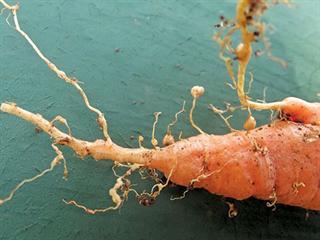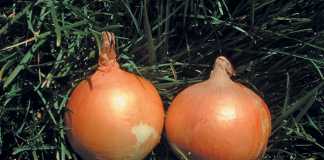
Worse, eelworms prefer sandier soils, where they can move more easily. And it’s precisely these lighter soils that are favoured by carrot growers, as they allow for a smoother, more uniform root and ease of lifting and cleaning. Consequently, we always need to know the eelworm status of any land in which we plant carrots.
Many farmers who grow a range of vegetables have lands that are infested with the beet cyst eelworm (Heterodera schachtii). By treating for this pest – which is very difficult to kill – they easily wipe out the root knot eelworm. So these farmers do not have an eelworm problem with carrots.
Strange as it may seem, virgin soil can prove a problem. A farmer I knew assumed that as he was planting carrots on what had once been veld, he did not need to fumigate. It was a costly mistake. That land turned out to have one of the worst eelworm infestations on carrots that I have ever seen.
Check roots of previous crops
Apart from conducting a soil test, you can also check the eelworm status of a land by examining the roots of previous crops. Beans, Swiss chard, beet and many other vegetables host root knot nematodes. When harvesting these, check for signs of eelworm even if you are not going to plant carrots next. I got caught out once when I planted Swiss chard after beans, without checking the beans too closely. I soon noticed distinct lines where the Swiss chard was stunted.
Read: Carrots – Who said they must be orange?
These corresponded with the position of the bean rows from the previous crop. An examination of the roots showed eelworm. When you have an active population in the soil and plant another susceptible crop, the eelworm problem explodes.
Carrots are particularly vulnerable when just starting off. The eelworm enters the root at the tip and starts feeding. A round lump forms that increases in size with age, causing the plant to send out side-roots to bypass the restriction.
These render the root unmarketable. If you plant in winter, the problem may be averted to some extent as soil temperatures are too low for eelworms to be active. And as the weather warms, the nematode may only attack the smaller side roots, causing less damage.
Soil fumigants – effective, but use with care
There are several ways to kill the nematodes. One is to use a soil fumigant before planting. This is an expensive and precise process: follow the directions carefully and monitor the soil temperature, as it needs to be in the prescribed range for the product. Fumigants produce a gas, which needs two weeks to dissipate. It may take even longer, depending on soil temperature, structure and moisture content. Importantly, there should be no gas smell when you dig into the soil, or the crop may be harmed.
Some products can be sprayed and worked into the soil just before planting, while others can be applied during growth.
With carrots, it is always preferable to remove the eelworm prior to planting, as the pests can strike as soon as the carrot root penetrates the soil. You can also plant ‘trap crops’ before planting carrots. These are usually mustards and oil
radishes bred especially for the purpose, but make sure that the variety chosen is effective against the specific eelworm species found in the soil. You can do this by sending a soil sample for analysis.
Whatever you do, stick to the simple rule: never plant carrots without knowing the eelworm status of the soil!












